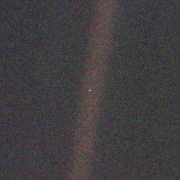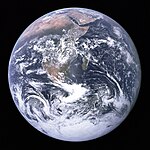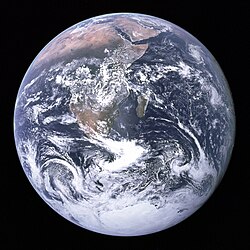Bleka blå pricken

Bleka blå pricken (engelska: Pale Blue Dot) är ett fotografi av planeten jorden, taget av rymdsonden Voyager 1 från ett distansrekord, visande jorden i jämförelse med rymdens omfång. Det är också namnet på en bok utgiven 1994 av astronomen Carl Sagan, som inspirerades av fotot.
Fotografiet
Carl Sagan och Carolyn Porco fick idén att ta ett familjeporträtt av solsystemet. Uppdragsledningen var först tveksam, och tidigare hade de varit oroliga att kameran skulle ta skada av det relativt kraftiga ljuset, men fick ordern om bilden genom dåvarande Nasaadministratören Richard Truly. Den 14 februari 1990 beordrade således Nasa Voyager 1, som just fullbordat sitt uppdrag, att vända sig om för att fotografera planeterna i solsystemet.[1] Ett fotografi som Voyager 1 återförde visade jorden som en "blek blå prick" i världsrymden. Sagan återger distansen som 3,7 miljarder engelska mil i sin bok, medan Nasas webbplats beskriver det som "mer än 4 miljarder engelska mil" (6,4 miljarder kilometer). Voyager tog liknande bilder av Venus, Jupiter, Uranus och Neptunus, och skapade ett porträtt av solsystemet. Merkurius närhet till solen förhindrade den från att bli fotograferad och Mars var inte synlig på grund av det starka solskenet mot kamerans optik.
I en avslutande föreläsning den 11 maj 1996 relaterade Sagan till sina tankar om en djupare mening med fotografiet:[2]
| ” | Look again at that dot. That's here. That's home. That's us. On it everyone you love, everyone you know, everyone you ever heard of, every human being who ever was, lived out their lives. The aggregate of our joy and suffering, thousands of confident religions, ideologies, and economic doctrines, every hunter and forager, every hero and coward, every creator and destroyer of civilization, every king and peasant, every young couple in love, every mother and father, hopeful child, inventor and explorer, every teacher of morals, every corrupt politician, every "superstar," every "supreme leader", every saint and sinner in the history of our species lived there – on a mote of dust suspended in a sunbeam. The Earth is a very small stage in a vast cosmic arena. Think of the rivers of blood spilled by all those generals and emperors so that, in glory and triumph, they could become the momentary masters of a fraction of a dot. Think of the endless cruelties visited by the inhabitants of one corner of this pixel on the scarcely distinguishable inhabitants of some other corner, how frequent their misunderstandings, how eager they are to kill one another, how fervent their hatreds. Our posturings, our imagined self-importance, the delusion that we have some privileged position in the Universe, are challenged by this point of pale light. Our planet is a lonely speck in the great enveloping cosmic dark. In our obscurity, in all this vastness, there is no hint that help will come from elsewhere to save us from ourselves. The Earth is the only world known, so far, to harbor life. There is nowhere else, at least in the near future, to which our species could migrate. Visit, yes. Settle, not yet. Like it or not, for the moment, the Earth is where we make our stand. It has been said that astronomy is a humbling and character-building experience. There is perhaps no better demonstration of the folly of human conceits than this distant image of our tiny world. To me, it underscores our responsibility to deal more kindly with one another and to preserve and cherish the pale blue dot, the only home we've ever known. | „ |
Al Gores dokumentär An Inconvenient Truth (2006) presenterade fotografiet av den "bleka blå pricken" i slutet av filmen. Gore använde den i sitt bildspel för att understryka behovet av att stoppa den globala uppvärmningen och citerade Carl Sagan med uttalandet: "That's all we've got" (svenska: "Det är allt/det enda vi har").
Referenser
- ^ Pale Blue Dot Arkiverad 27 september 2007 hämtat från the Wayback Machine. The Planetary Society (engelska)
- ^ Reflections on a Mote of Dust Arkiverad 27 september 2007 hämtat från the Wayback Machine. (engelska)
Se även
| |||||||||||||||||||||||||||||||||||||||
Media som används på denna webbplats
"The Blue Marble" is a famous photograph of the Earth taken on December 7, 1972, by the crew of the Apollo 17 spacecraft en route to the Moon at a distance of about 29,400 kilometres (18,300 mi). It shows Africa, Antarctica, and the Arabian Peninsula.
Cropped from ‘Pale Blue Dot’, see below.
Original Caption Released with Image: The cameras of Voyager 1 on Feb. 14, 1990, pointed back toward the sun and took a series of pictures of the sun and the planets, making the first ever "portrait" of our solar system as seen from the outside. In the course of taking this mosaic consisting of a total of 60 frames, Voyager 1 made several images of the inner solar system from a distance of approximately 4 billion miles (6.4 billion kilometers) and about 32 degrees above the ecliptic plane. Thirty-nine wide angle frames link together six of the planets of our solar system in this mosaic. Outermost Neptune is 30 times further from the sun than Earth. Our sun is seen as the bright object in the center of the circle of frames. The wide-angle image of the sun was taken with the camera's darkest filter (a methane absorption band) and the shortest possible exposure (1/125 second) to avoid saturating the camera's vidicon tube with scattered sunlight. The sun is not large as seen from Voyager, only about one-fortieth of the diameter as seen from Earth, but is still almost 8 million times brighter than the brightest star in Earth's sky, Sirius. The result of this great brightness is an image with multiple reflections from the optics in the camera. Wide-angle images surrounding the sun also show many artifacts attributable to scattered light in the optics. These were taken through the clear filter with one second exposures. The insets show the planets magnified many times. Narrow-angle images of Earth, Venus, Jupiter, Saturn, Uranus and Neptune were acquired as the spacecraft built the wide-angle mosaic. Jupiter is larger than a narrow-angle pixel and is clearly resolved, as is Saturn with its rings. Uranus and Neptune appear larger than they really are because of image smear due to spacecraft motion during the long (15 second) exposures. From Voyager's great distance Earth and Venus are mere points of light, less than the size of a picture element even in the narrow-angle camera. Earth was a crescent only 0.12 pixel in size. Coincidentally, Earth lies right in the center of one of the scattered light rays resulting from taking the image so close to the sun.




